The 14 Best Climbing Plants for Your Trellis or Pergola
Grow your own shade with these cool and colorful garden plants.
Fact checked by Isaac Winter
Pergolas and trellises are red hot for backyards—and they're also a great way to introduce some much-needed shade for outdoor entertaining. While you can always opt for canvas shades or other manmade options, adding climbing plants to your garden adds beauty along with some much needed respite from the shade.
But choosing the right climbing plants for your trellis or pergola can be challenging with so many gorgeous options out there, from flowering plants to intriguing foliage to even fruits and vegetables. Here's what to consider—and a few different plants to get you started.
Meet Our Expert
Zolene Quindoy, head horticulturist at Yardzen
Blythe Yost, co-founder and chief landscape architect of Tilly Design
Best Climbing Plants for Your Garden
Clematis
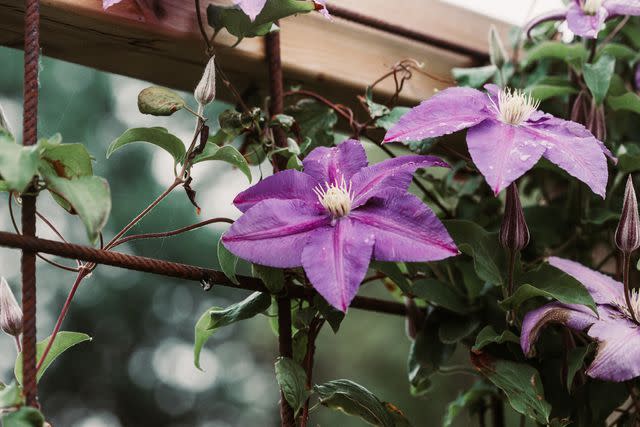
Helaine Weide / Getty
This pretty perennial comes most frequently in shades of purple, pink, and white, and can grow up to 20 to 30 feet, depending on the variety you choose. (Just look at the info carefully, as some varieties only grow two to five feet!)
Clematis can be fast growers, if you're looking to add shade quickly, and can also thrive in part-shade spots—though you'll likely get more blooms if you plant them in full sun.
They climb by using delicate and small tendrils to hold onto the climbing surface, so if you want them to climb a larger structure, add a grid or screen with thin wires they can climb.
USDA Hardiness Zones: 4 to 9
Soil: moist, well-drained, neutral
Light: Full sun
Size: 3 to 30 feet tall
Related: Here's a Full Guide to the USDA Gardening Zones
Climbing Hydrangea
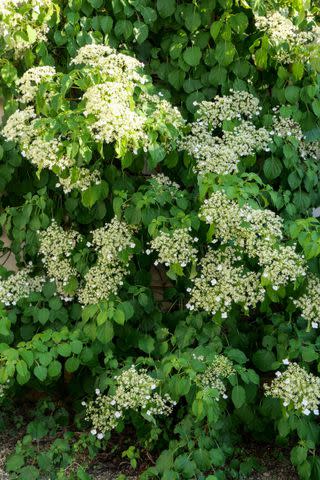
Wirestock/Getty Images
If you need a climbing plant that thrives in shade, a climbing hydrangea is your best bet. "I love climbing hydrangea for a shady wall because it’s a beautiful texture and a large flower that will make a statement," says Blythe Yost, co-founder and chief landscape architect of Tilly Design.
Climbing hydrangeas bloom white all summer, and its leaves turn a gorgeous golden yellow in the fall.
USDA Hardiness Zones: 5 to 7
Soil: moist, well-drained, acidic
Light: partial shade to full sun
Size: 30 to 50 feet tall
Related: How to Care for Hydrangeas—Whether Potted, Planted, or in a Bouquet
Trumpet Vine
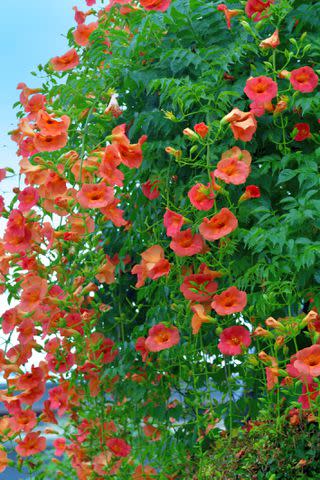
Getty Images
This vine is a stunner, growing up to 40 feet tall with gorgeous red-orange blooms. It thrives in full sun or part shade—but it'll need regular pruning to help you keep it from overtaking your whole yard.
USDA Hardiness Zones: 4 to 9
Soil: moist, well-drained, acidic
Light: partial shade to full sun
Size: 25 to 40 feet tall
Moonflower
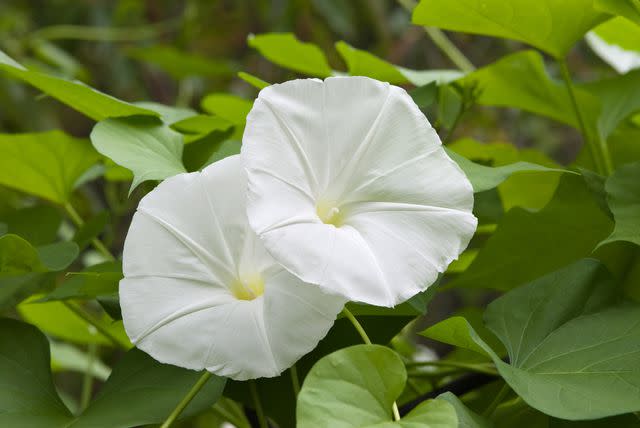
Ellenmck / Getty Images
If you're planning a lot of nighttime entertaining, a moonflower plant may be a beautiful addition to your garden. "Moonflower is a fun vine that has huge—four to six inches across—blooms that open at night," says Zolene Quindoy, head horticulturist at Yardzen. "Their sweet scent and white color are meant to attract moths, but these same traits make them a wonderful addition to a moon garden—a white flower-themed garden that can be enjoyed at night."
Moonflowers can be perennial in the hottest parts of the country, but will be an annual elsewhere. And despite its nocturnal blooming habits, it needs plenty of sun to thrive.
USDA Hardiness Zones: 10 to 12
Soil: moist, well-drained, slightly acidic
Light: full sun
Size: 10 to 15 feet tall
Bougainvillea
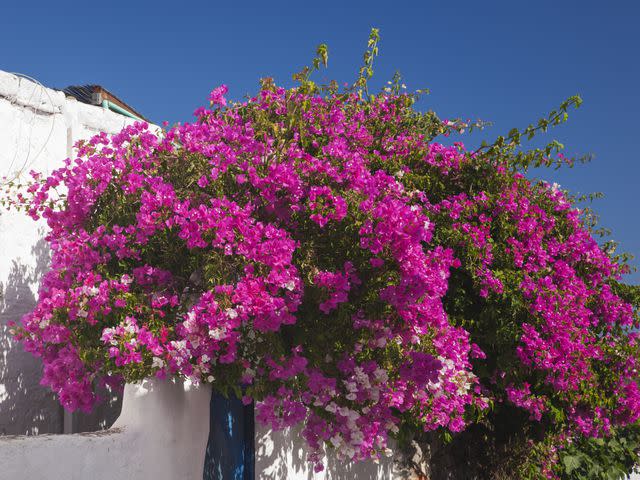
David C Tomlinson/Getty Images
The papery petals of this vine are technically called "bracts" (similar to poinsettias, actually) and they're quite tolerant of tough conditions like heat and dry spells. They can grow up to a whopping 40 feet tall!
USDA Hardiness Zones: 10 to 11
Soil: moist, well-drained, slightly acidic
Light: full sun
Size: 15 to 40 feet tall
Star Jasmine
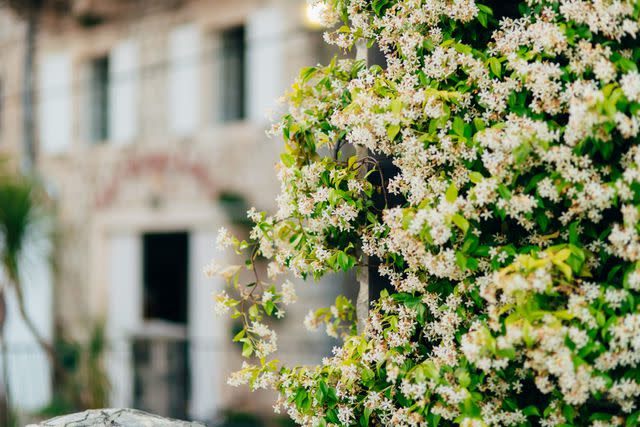
This pretty scented vine is a perfect addition to your trellis or pergola, with its lush foliage and tiny blooms. "I love adding fragrant vines near windows or outdoor gathering areas so the scent can be easily enjoyed," Quindoy says.
Star jasmine can grow in both full sun and partial shade, and can grow up to six feet tall.
USDA Hardiness Zones: 8 to 10
Soil: moist, well-drained, slightly acidic
Light: partial shade to full sun
Size: up to 6 feet tall
Climbing Roses
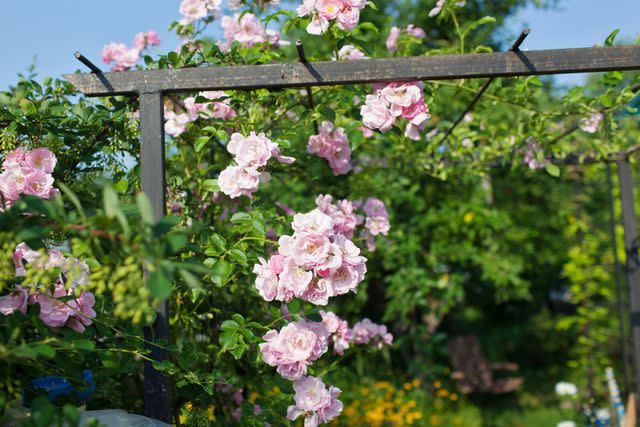
Salomatin/Getty Images
Roses are a traditional climbing flower for trellises and pergolas, with its wide array of colors and types available to suit any garden. Just keep the thorns in mind!
Climbing roses do best in part shade or full sun, and you'll need to bend and tether the canes of your rose plant to train it onto the structure you want it to climb.
The average climbing rose reaches about eight feet in height, but they can grow up to 20 feet tall.
USDA Hardiness Zones: 4 to 11
Soil: moist, well-drained, neutral to slightly alkaline
Light: partial shade to full sun
Size: 3 to 20 feet tall
Mandevilla
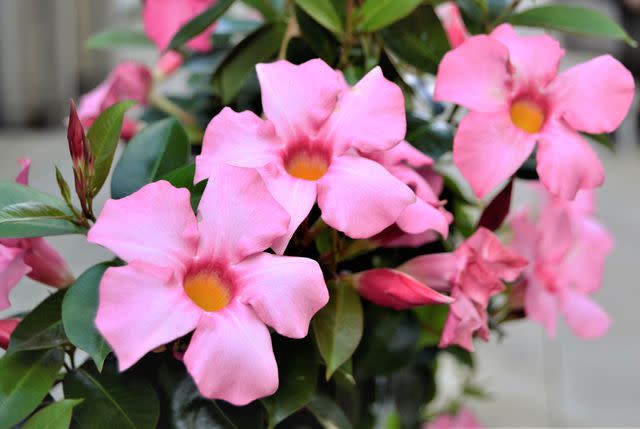
Blanchi Costela/Getty Images
Mandevilla flowers are trumpet-shaped and appear in varying shades of red, pink, and white. Because it's a tropical plant, it won't do well once it gets frosty.
USDA Hardiness Zones: 5 to 11
Soil: sandy, well-drained, neutral to slightly acidic
Light: full sun
Size: 3 to 8 feet tall
Honeysuckle
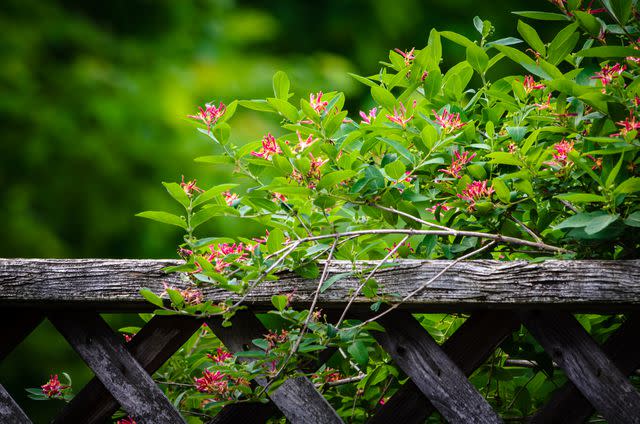
Grb/Getty images
These super fragrant blooms are a favorite with bees—and are actually considered invasive in some areas, depending on the type of honeysuckle you're growing. The flowers can come in shades of yellow, red, white, pink or purple, and the plant itself can grow up to 20 feet tall (perfect for a large pergola!). Honeysuckle doesn't love full sun, so plant it where it can get some shade in order for it to thrive.
USDA Hardiness Zones: 5 to 9
Soil: moist, well-drained, neutral to slightly acidic
Light: partial shade to full sun
Size: 8 to 12 feet tall
Sweet Pea
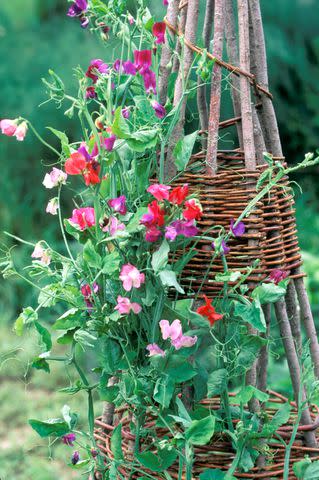
This pretty flowering vine doesn't produce edible pea pods (in fact, they're toxic!)—but it offers plenty of bright, fragrant blooms in the summer and fall. It thrives in the sunshine and can grow up to eight feet tall.
USDA Hardiness Zones: 3 to 8
Soil: well-drained, neutral to slightly alkaline
Light: partial shade to full sun
Size: up to 8 feet tall
Morning Glory
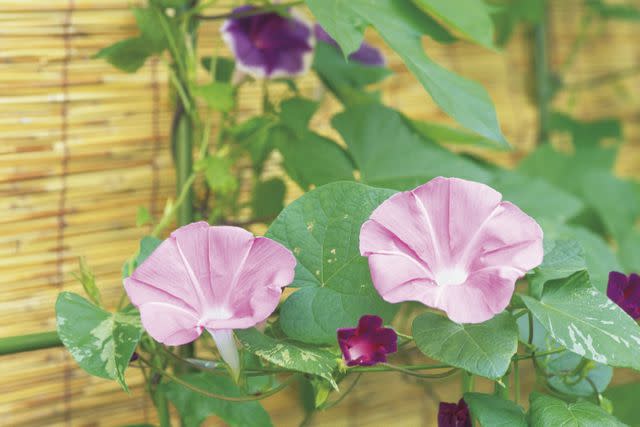
GYRO PHOTOGRAPHY/Getty Images
This pretty flowering vine is an annual that grows from seeds, and can grow up to 10 feet tall and produce plenty of gorgeous white, pink, purple, or blue blooms on its vines. While popular with butterflies and bees, the plant can be toxic to pets. They need full sun to thrive.
USDA Hardiness Zones: 2 to 11
Soil: moist, well-drained, neutral
Light: full sun
Size: 3 to 10 feet tall
Related: How to Create a Pollinator-Friendly Garden
Black-Eyed Susan
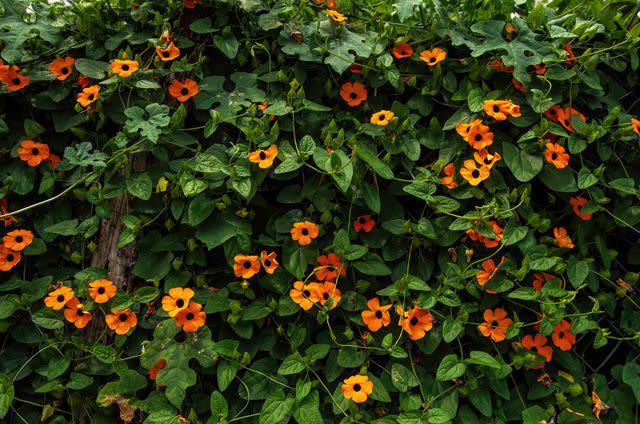
Simon McGill/Getty Images
These dotted blooms grow very quickly—within a month of purchasing and planting they can flower—and can reach up to 8 feet tall. Despite their tropical roots though, they can be grown pretty far north as annuals.
USDA Hardiness Zones: 10 to 11
Soil: moist, well-drained, neutral
Light: partial shade to full sun
Size: 3 to 10 feet tall
Virginia Creeper
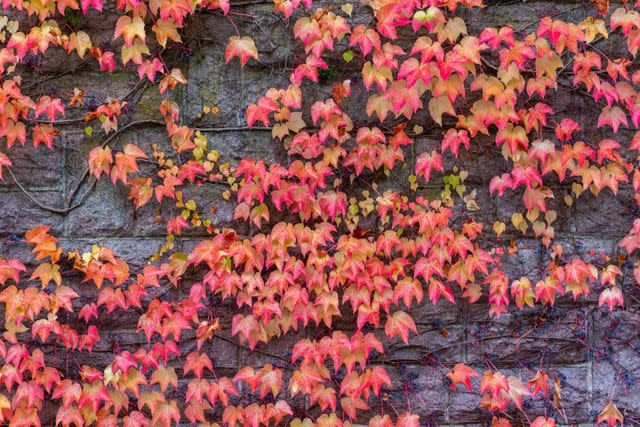
Yulia-Images/Getty Images
For a leafy look, try Virginia Creeper, which has a stunning red hue in the fall. The leaves do shed as the weather cools down. It thrives in full sun, but can handle partial shade and almost any kind of soil.
USDA Hardiness Zones: 10 to 11
Soil: moist, well-drained, neutral
Light: partial shade to full sun
Size: 15 to 20 feet tall
Wisteria
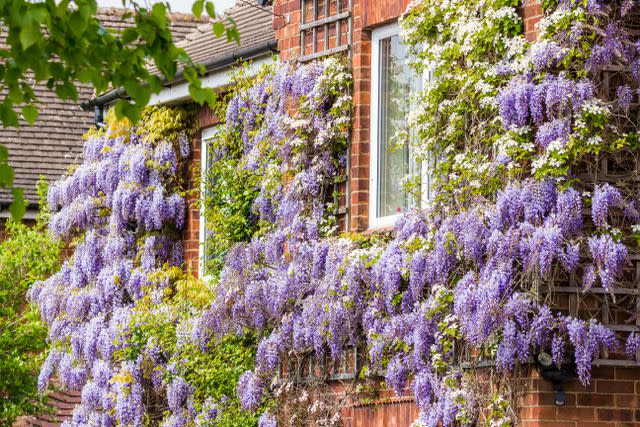
Clive Wells/Getty Images
Wisteria flowers are beloved for their lilac-colored blooms—the clusters of petals almost look like grapes from afar and drape beautifully over a pergola. They also impart a subtle, sweet scent.
USDA Hardiness Zones: 4 to 9
Soil: moist, well-drained, slightly acidic
Light: partial shade to full sun
Size: 15 to 20 feet tall
Tips for Choosing Climbing Plants for Your Garden
Keep in mind how the pergola or trellis will be used
For an archway trellis in an out-of-the-way part of your garden, the sky's the limit, but if you're planning to use the space under your pergola for entertaining or as a well-trafficked entryway, you may need to be more mindful about your plant choices.
"Vines like bougainvillea and climbing roses can grow quite large and their thorny branches can be an issue if planted next to a walkway," says Quindoy. If bees buzzing around your patio will disrupt your get-togethers, look for low-fragrance flowers that don't attract pollinators.
And you may need to be on regular cleanup duty if your pergola is over your outdoor living space. "All plants shed in some capacity and so will a vine," says Yost. "Tables or furniture underneath may be covered in debris at certain times of the year." For example, a grapevine-covered trellis becomes a bird-feeding frenzy mid-summer, resulting in a constant need to clean the patio.
Understand the plant's growth habits
A plant that can grow up to 20-feet long could easily overpower a small trellis, while a more delicate vine may not provide enough shade for your space.
Climbing plants use different techniques to climb a structure—some of which may not be something you desire. "Some have twining stems or tendrils that wrap around vertical supports—think sweet peas, clematis, passionflower—while others attach themselves to surfaces via aerial pots or adhesive pads, including true ivy, Boston ivy, Virginia creeper, and climbing fig," says Quindoy. "These vines can be extremely difficult to remove and can damage the surfaces they were once attached to."
You'll also need to consider what the plant needs to thrive. "Remember that plants have light and water requirements that you need to take into consideration for the specific space you are looking to add climbing vines," Yost says. "The north side of any building is generally shady, so you’ll need something that works in shade."
Watch out for invasive plants
"By definition climbing plants are invasive," Yost says. "Some with rapid growth habits—ivy, wisteria, and akebia—can get out of hand and take over a garden. Others are more well behaved, such as clematis and lonicera."
Related: 15 Popular Plants You Should Never Grow in Your Yard
A few climbing plants to reconsider for your garden:
• Chinese Wisteria
• English Ivy
• Chinese Bittersweet
• Kudzu
• Concord Grapes
• Porcelain Vine
• Silver Lace Vine
• Chocolate Vine (Akebia quinata)
Keep your pets and kids safe
A few common vines, like wisteria and Carolina jessamine, can be toxic to pets and kids, so you may want to reconsider them if you're concerned about the exposure.
Consider mixing two or more plants on the same structure
If you fall in love with more than one type of plant, you might be able to mix and match to create a perfect look. "Climbing roses and clematis are a great combination," Yost says. "The rose provides a structure for the clematis to climb up and the clematis adds substance to lower spindly stems."
For more Real Simple news, make sure to sign up for our newsletter!
Read the original article on Real Simple.

